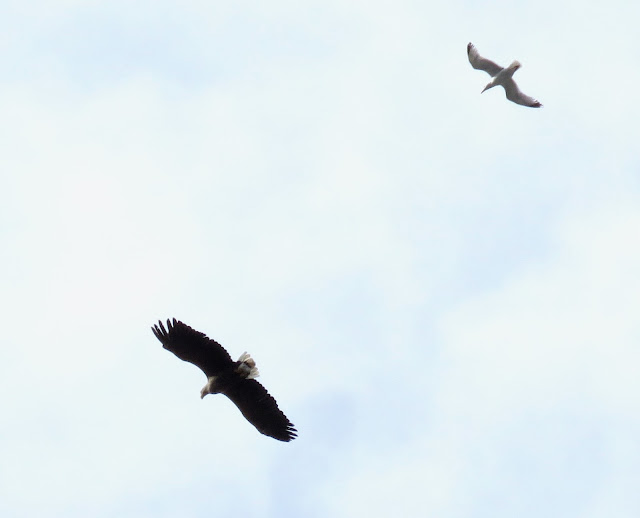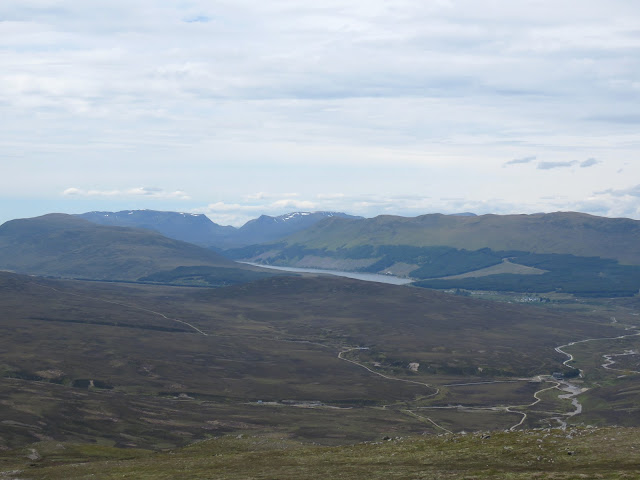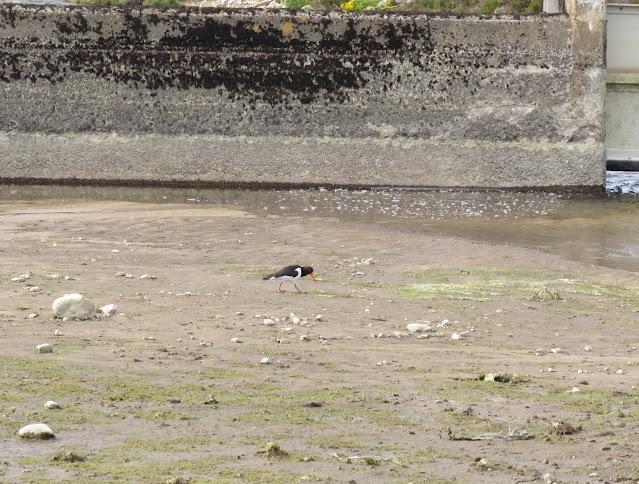Friday, June 24, 2022
There was always the risk that a trip on the ferry during the current devastating outbreak of avian flu would be a voyage through a seabird graveyard - but the first dead creature we saw was a sheep.
Someone pointed out a pod of dolphins, and a bit later we saw a few more; we also had a couple of sightings of porpoises. At Stornoway we had good views of common terns in the harbour; and on the return trip we saw kittiwakes and a couple of fulmars. We passed one dead seabird, the greyish webbed foot perhaps suggesting gannet (we also saw several live gannets, thank goodness).
The wind got up in the afternoon and the sea was quite choppy; we failed to see any more shearwaters, Arctic skuas or cetaceans. Arriving back in Ullapool, we stayed on deck until the last moment as this was preferable to crowding round the exit below in a confined space with loads of other people (Covid hasn't gone away) and I had just packed the camera into my rucksack when a racket from above made me look up - to see a white-tailed eagle being mobbed by several herring gulls.
Tuesday, June 14, 2022
How we managed to gain another Munro tick without going anywhere! Greger showed me a really nice YouTube video yesterday, taken by a walker of his day's outing on Liathach - walking from east to west. He had beautiful weather for it, and Greger was particularly struck by the lower path he took to avoid the rocky pinnacles - because that's the path we took back in 1993. The weather we had was shocking, with hardly any visibility - so we weren't really aware of just how exposed the path was in places; in fact, going over the tops of the pinnacles might have been easier! Of course, it's probably become more eroded over the intervening years - but Greger says he can remember thinking it was a bit hairy even then. There are two tops on the ridge that count as Munros, and towards the end the video showed the second one (Mullach an Rathain) before the man began his descent.
Something about that summit shot made me sit up. I asked Greger to go back to it; yes, there it was, a smallish cairn - and nothing else. "Where's the trig point?" I said. Where indeed?
For our 1993 walk we took with us just the larger scale map with the yellow cover. It shows no trig point symbol on the western Munro, so we weren't looking for one - just a cairn. Happy that we'd reached the top - even though we could see nothing in the cloud and the drizzle - we immediately started down the steep, leg-testing slopes to the road.
All well and good. But that evening, back at the hostel, I glanced at the smaller scale map (middle one in the picture) and was dismayed to see a trig point symbol on the top we thought we'd reached.
Tuesday, June 07, 2022
Meall Chuaich (Drumochter)
Alongside the broad estate track runs an aqueduct; sand martins were hunting above it and a willow warbler perched momentarily on the fence. Our destination was the 951m hill in the centre, and there's a four-and-a-half kilometre walk-in before we start the real climb.
Two redpolls flew out of a conifer plantation and foraged busily on the dusty ground.
Just beyond the plantation is Cuaich hydro-electric power station; house martins and sand martins were swooping round the building, and the muddy area beyond looked good for waders. A family of red grouse was nice to see although our delight at the tiny chicks was tempered by the knowledge that this is a shooting estate. Further upstream, an estate worker had stopped his truck and was scanning with bins. He told us there was an oystercatcher chick somewhere by the river; he wished us a good walk and on we went. We paused to look at a wire cage with what looked like some sort of spring trap inside, placed on a log over a stream. As it was in a conspicuous spot, perfectly visible to walkers, we assumed it was a legal one. A probable grey wagtail flew over to the river and Greger got me onto a common sandpiper as it disappeared round a bend.
Leaving the track we began to trudge up steep, sometimes stony, heathered slopes. A wheatear was seen. Pausing for a breather we looked along Loch Ericht to Ben Alder and other remote Munros; the river valley we've walked up is to the right.
It was reassuring on reaching the lower top to find the heather becoming sparser, and tundra-like vegetation taking its place. I think this is fir clubmoss.
Crowberry was everywhere, which made me hopeful of ptarmigan as they feed on its berries (I'd also spotted a couple of white feathers on the ground).
We were preparing to follow the ridge when a path led off to the left. Normally I'd prefer to stay high but we followed the path and I'm glad we did, because we came across a patch of cloudberry - and for once we were in time to see it in flower. My mind went back to another small flower (mountain avens) dotting a rocky slope with white, and I counted myself lucky to have seen both in the same year.
Approaching the summit cairn of Meall Chuaich.....
.....and reaching it!
Time for lunch; but we couldn't find both comfortable rocks and shelter from the wind, so had to put up with being blown about while we ate. The views were stupendous although we didn't always know what we were looking at. (Getting a map out in the wind just asks for trouble.)
I had a walkabout. An anxious call was heard - and a golden plover came flying over swiftly to the east.
Having sat still for some time we were now feeling really cold in the strengthening wind and so, after a final admiring look at the views, we set off down. I turned for a last look at the moss-carpeted summit dome and the huge cairn with its attendant rusty fence posts; it was easy to imagine dotterel running here - but frequent scans through the bins brought nothing.
Greger pointed to a raptor soaring over a distant ridge; it soon disappeared, so this record shot will have to do. But it does prove it's a golden eagle.
This was a nice surprise and it was a bonus to see my first ring ouzel of the year while on a hill-walk. He eventually flew strongly away, over the moorland and out of sight. Back near the power station we had good views of a common sandpiper, and an oystercatcher on the mud provided our last "tick" of the walk.
Friday, June 03, 2022
It was a beautiful day for a walk at Clachtoll - once we'd negotiated a ticket machine that didn't seem to be working. A passer-by was helpful, having sussed that you needed to reach right up into the machine to grab your ticket; the one that had popped out (for a shorter stay than we'd paid for) belonged to the previous customer - who must have given up! We're not against parking charges (new here this year) but they should at least make sure the machines work.
Up on the cliffs, the wind was decidedly cool and we didn't regret wearing our jackets. Later on, down near the broch, a young man asked if we'd read a different weather forecast. True, most people were in shorts, but I didn't see what business it was of his what we were wearing. However, when Greger pointed out that he'd had on a T-shirt proclaiming he was a republican, I forgave him.
A white-tailed sea eagle was a fine sight as it flew high across the blue, blue sky.
We retraced our steps, finding a short cut to the dunes so that we didn't have to run the full gauntlet again (mind you, no-one gave us a second look - they were all too busy enjoying the wonderful day, as well they might) and then set off on the drive home. The camp-site at Clachtoll had a notice out to say it was full; and the roads were pretty busy, mostly with "great whites" (as a man in Greger's Spanish class dubbed the larger camper vans). The summer season has well and truly begun.
Thursday, June 02, 2022
Yesterday: After all the wind and rain that plagued the month of May, the first day of June was a huge boost for the spirits! Under blue skies and in warm sunshine, we walked down to the harbour early to buy tickets for the ferry and set off with high hopes on our latest pelagic.
The ferry was packed. We both failed to hear an announcement that was made, and a woman standing next to me at the rail said there was to be a training session with a helicopter. Then the red-and-white Coastguard helicopter was seen in the distance. It flew across our wake and hovered above the end of one of the Summer Isles; I think it was Priest Island. Two white-tailed eagles rose from the island - I've just caught them on the right-hand side of the picture.
They flew around rather than away - which made me wonder if they're breeding on the island. Wouldn't the Coastguard know? Maybe not.
Anyway, this was soon forgotten as the big Sikorsky completed that manoeuvre and started to fly after us. Closer and closer it came, like a huge bee in the clear blue sky. The man next to Greger proudly told him that his mate was flying it - they'd been together in Northern Ireland apparently, army pilots flying Lynx helicopters. The decks were now full of people, and countless arms were raised, holding aloft smartphones. When the helicopter had hovered for some time, at one point coming even closer, a man was winched down onto the ferry behind the car deck and then winched back up.


.jpeg)



.jpeg)


















.jpeg)







.jpeg)
